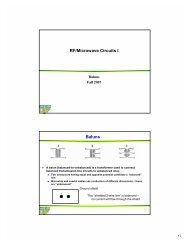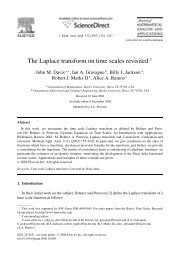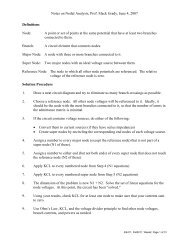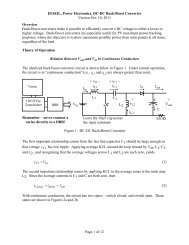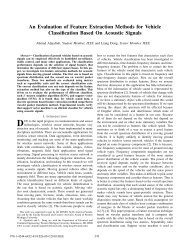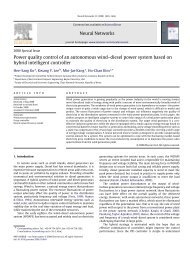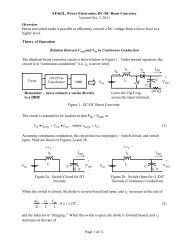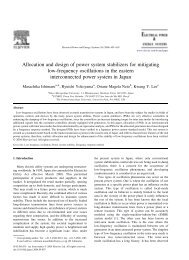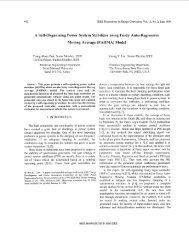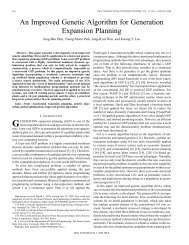EE462L, Power Electronics, H-Bridge Inverter Version Nov. 6 ... - ECS
EE462L, Power Electronics, H-Bridge Inverter Version Nov. 6 ... - ECS
EE462L, Power Electronics, H-Bridge Inverter Version Nov. 6 ... - ECS
Create successful ePaper yourself
Turn your PDF publications into a flip-book with our unique Google optimized e-Paper software.
<strong>EE462L</strong>, <strong>Power</strong> <strong>Electronics</strong>, H-<strong>Bridge</strong> <strong>Inverter</strong><br />
<strong>Version</strong> <strong>Nov</strong>. 6, 2011<br />
I. Introduction. In this experiment, you will build the H-<strong>Bridge</strong> portion of your inverter, connect your<br />
PWM control circuit to it, and then convert 35-40Vdc power to 60Hz ac, about 100W.<br />
II. Build the Circuit. DO NOT use the optional output filter for now.<br />
C1’s are 100µF, 160V low ESR. C2’s are 0.01µF, 50-100V ceramic.<br />
Others 100µF caps are 25V, low ESR.<br />
Page 1 of 5
<strong>EE462L</strong>, <strong>Power</strong> <strong>Electronics</strong>, H-<strong>Bridge</strong> <strong>Inverter</strong><br />
<strong>Version</strong> <strong>Nov</strong>. 6, 2011<br />
1. No DBR yet.<br />
2. Join your PWM controller to the H-<strong>Bridge</strong> using two sets of nylon screws and threaded spacers. To<br />
connect the +,-,A,GND,B,GND holes, lay small #22 wires from hole to hole, soldering them on top<br />
of the boards.<br />
3. <strong>Power</strong> up the PWM controller, using an AC wall wart for Vcont. The AC wall warts have yellow<br />
paint, and some have audio plug outputs.<br />
4. Make sure your PWM controller is working properly, e.g., Vtridc, VAB symmetry, in linear and<br />
overmodulation.<br />
5. One by one, use a scope to view VGS on each MOSFET. With Vcont = 0, you should see 50% duty<br />
cycle waveforms. As you increase Vcont, the VGS waveforms begin to sweep through the duty<br />
cycle variation as determined by the H-<strong>Bridge</strong> comparator logic.<br />
With Vcont = 0, each VGS is steady as shown<br />
above<br />
As you raise Vcont, each VGS takes on the<br />
periodic duty cycle width as determined by the<br />
PWM control logic<br />
6. With no load on the H-<strong>Bridge</strong> output, slowly raise variac/transformer/DBR to the usual 35-40Vdc.<br />
If you see any steady variac ammeter reading, or blow a fuse, you have a short circuit someplace that<br />
must be resolved. View H-<strong>Bridge</strong> output Vac on a scope.<br />
7. Turn off the variac and rotate the dial to zero.<br />
8. Connect a 5Ω power resistor to the H-<strong>Bridge</strong> output, then turn it on and raise the variac so that the<br />
DBR output voltage is 10V.<br />
Page 2 of 5
<strong>EE462L</strong>, <strong>Power</strong> <strong>Electronics</strong>, H-<strong>Bridge</strong> <strong>Inverter</strong><br />
<strong>Version</strong> <strong>Nov</strong>. 6, 2011<br />
9. View the PWM controller’s VAB output, and adjust Vcont so that you are just below the<br />
overmodulation point. Then, move the scope probe to view Vac across the 5 Ω load resistor. My<br />
multimeter reading was 5.6Vrms.<br />
10. Slowly increase Vdc to about 35V. The AC voltage on my 5Ω load resistor rose to about 18.6Vrms,<br />
which corresponds to 69W. Operate for about 5 minutes and feel the MOSFET heat sinks. They<br />
should be slightly and uniformly warm.<br />
Page 3 of 5
<strong>EE462L</strong>, <strong>Power</strong> <strong>Electronics</strong>, H-<strong>Bridge</strong> <strong>Inverter</strong><br />
<strong>Version</strong> <strong>Nov</strong>. 6, 2011<br />
11. My AC voltage waveform improved considerably when I used CF = 4.7nF, which corresponded to a<br />
triangle wave frequency of 44 kHz.<br />
Page 4 of 5
<strong>EE462L</strong>, <strong>Power</strong> <strong>Electronics</strong>, H-<strong>Bridge</strong> <strong>Inverter</strong><br />
<strong>Version</strong> <strong>Nov</strong>. 6, 2011<br />
Page 5 of 5




